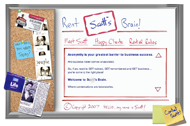 “I just cannot WAIT to send you a check!”
“I just cannot WAIT to send you a check!”
How cool would it be if your customers thought that? How profitable would it be if your customers SAID that?
Very.
And the best part is, this concept has nothing to do with selling; but rather, enabling people to buy.
IN SHORT: Being buyable.
AND HERE’S THE DISTINCTION: Most salespeople constantly run around asking prospects, “Do you want to buy me?”
On the other hand, buyable salespeople don’t run – they position. And they do so in a value-driven, unique role so prospects say to them, “We want to buy you!”
MY QUESTION IS: How’s your buyability?
Not strong enough? Not a problem. Let’s explore a list of eight strategies for becoming more buyable than a bottle of Viagra at a bingo hall.
1. Migrate fans into paying customers. In order to do so, you MUST deliver unique value first. Ideally: Meaningful, concrete and immediate answers that will help your customers grow their business – delivered via email, blogging, a public presentation or an in-person meeting.
And, yes, this migration process may take months, even years. The question you have to ask yourself is: What are you willing to LOSE on the first sale in order to guarantee a relationship? Time? Lunch? Money? Free samples? A few hundred bucks?
It might be worth it. Start building your migration strategy today. How long will it take to turn strangers into friends, friends into fans and fans into paying customers?
2. Try your customer’s head on. First, ask yourself: “If I were my customer, what would I want to buy from me next?” Second, ask your customers, “What new offering would you LOVE to see from me that I don’t currently offer?”
Example: I recently asked that very question to the 20,000 subscribers of HELLO, my name is Ezine. I also offered a free book to whomever offered the best most helpful suggestion. Sure enough, heaps of emails came in. My customers’ feedback was priceless. I even modified one of my future programs accordingly.
Lesson learned: Your customers will tell you how to sell to them. Remember what sales legend Jeffrey Gitomer reminds us, “People hate to be sold, but they love to buy.” Are you giving your customers permission to tell you how to serve them better?
3. More isn’t more. All you can eat buffets are great for heart disease, but ghastly for business. Here’s why: Choice saturation paralyzes people into inaction. And confused minds never buy. Conversely, the less you offer, the easier it is for people to refer TO and FROM you.
Not to mention, when you remove choices, you also remove the threat of rejection. Your mission is to arrange things so that selling is easy. And the first step to doing so is simple: Offer less.
In Seth Godin’s very short ebook, Do Less, he writes: “By not cluttering your life and reputation with a string of low-budget process, you actually increase your chances of getting great projects in the future.” What if you stopped giving customers so many choices, or any choice at all?
4. Reopen the wound. Here’s the reality: If there’s nothing bleeding, customers won’t think they need you. This doesn’t mean you should act like an evil pharmaceutical company that manufactures bogus diseases so they can push pills (ahem, Restless Leg Syndrome).
Rather, your job is to serve as a reminder. As if to say to your customers, “I think you’re forgetting that you have this problem, and it hasn’t gone away. So, if you want to eliminate it, you need to call me.” It’s all about framing. Presenting offerings in a way where resistance is impossible. Helping them WANT it. What were you designed to cure?
5. Keep asking: What’s next? According to the owner of Honest Selling and the founder of Yellow Tie International, Gil Wagner, “These are the two strongest words for maintaining control of the buying conversation.”
I agree. Especially on email. Especially when you’ve done your part and you’re waiting for the prospect to make a move. Instead of appearing too pushy, all you have to do is ask, “What’s next?” Period. End of email. You’ll find that it’s is a conversation-advancer, a time-saver and an action-oriented request that demonstrates your willingness to cut to the chase and move forward.
I’ve been using it almost daily since 2005, and I’m constantly amazed how (a) how many sales I’ve closed because of it, and (2) how much customers appreciate it. Remember: The listener controls. Are you asking simple, yet powerful questions to become more buyable?
6. People sell – products don’t. People buy people first. Period. So, if you notice a lack of buyability, realize that customers aren’t resisting the product – they are resisting you. Conversely, buyable people (and businesses) are the ones customers think, “Dude, we would be nuts NOT to hire this guy!” How could you become more irresistible?
7. Become a known-entity. The best way to do so is to achieve what I call “Radar Equity.” And it begins by asking yourself five few questions:
a. Whose radar do I want to be on?
b. What do I want to happen as a result of being on it?
c. Who do I know that is already on that radar?
d. What steps have they taken to get there?
e. What actions could I take to emulate those steps?
Remember: The secret to Radar Equity is that you have to EARN the right to be on it. That means publishing. That means social networking. That means OFF-line networking. Whatever it takes. How can you position yourself so thousands of people whom you never met will get to know you instantly?
8. Put yourself in their future. “I’m going to be happier at the end of this transaction because I gave you money.” This is what your prospects need to think. So, the first step toward reaching that future is to activate mental ownership. And you do this by helping the customers visualize the END.
The benefit of the benefit of the benefit of the benefit. The customers of the customers. Not just a mowed lawn – their kids and dogs playing in the freshly cut grass. Not just a rental car – their feeling of getting the hell out of the airport quickly. How are you traveling through time to put yourself in your customer’s future?
REMEMBER: Selling is for amateurs – enabling people to buy is the secret.
Ultimately, buyability is about creating a value-forward relationship within the client environment.
Do that, and they might actually become excited about sending you a check.
Then you can buy all the Viagra you want!
LET ME ASK YA THIS…
How are you boosting your buyability?
LET ME SUGGEST THIS…
For the list called, “134 Questions Every Salesperson Should Ask,” send an email to me, and you win the list for free!
* * * *
Scott Ginsberg
That Guy with the Nametag
Author, Speaker, Coach, Entrepreneur
[email protected]
 Need to build your Thought Leadership Platform?
Need to build your Thought Leadership Platform?
Perhaps my monthly (or yearly) coaching program would help.
Rent Scott’s Brain today!















